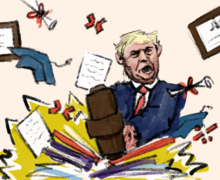President Donald Trump builds more than one wall with his latest executive orders
Emmy Gnat | Head Illustrator
Different experts weigh in on President Donald Trump's U.S.-Mexico border wall and its potential impacts.
United States President Donald Trump recently issued an executive order calling for the construction of a controversial wall along the entirety of the U.S.-Mexico border.
Trump needs congressional approval to authorize the building of the wall, and experts agree that because Congress currently has a Republican majority, the president will have little problem getting support for his plans.
The length of the border between the U.S. and Mexico is approximately 2,000 miles long. Almost 700 miles of fencing already exists along the border. There are several remote areas along the border that don’t have border fencing.
Since 2000 there have been more than 65 border walls built around the world, said Corri Zoli, a research assistant professor of political science in the Maxwell School of Citizenship and Public Affairs.
“We’re entering a new period of retrenchment of nationalism,” she said.
The construction of Trump’s wall is estimated to cost around $12-$15 billion, according to Senate Majority Leader Mitch McConnell. Trump has said he expects Mexico to pay for the wall. However, Mexico President Enrique Peña Nieto has frequently said his country will not pay for the border wall.
“The Trump administration is not initiating this on its own, even though it’s been a part of campaign rhetoric,” said Zoli, “We already have a significant investment in border fencing.”
Trump has discussed taking cuts from remittances to pay for the wall, but it is likely that the necessary funds for the project will come from U.S. taxpayers, said Gladys McCormick, an assistant professor of history in the Maxwell School.
Even though talks about the wall have strained U.S.-Mexico relations, McCormick said she doesn’t think the wall itself will have a big impact on U.S. relations with other Latin American countries.
Changes to immigration laws and renegotiating free trade contracts will have a bigger impact with other countries, McCormick said.
McCormick also said there might be unintended consequences of the wall, especially with environmental impacts. She said there are delicate habitats along the border that play important roles in migration of wildlife and the growth of flora and fauna. Construction of the wall will cause “catastrophic” environmental destruction, she said.
Amy Lutz, associate professor of sociology in the Maxwell School, said that until about the 1980s, immigration from Mexico was circular.
This meant, she said, that immigrants would come to the United States to work, but would eventually return back to Mexico. After 1994, with the Clinton administration’s introduction of Operation Gatekeeper, which increased the number of border patrol agents and upgraded their equipment, the border became more militarized. People still came to the U.S., but they have now stopped leaving, she said.
“(The wall) in some sense encourages people to stay because it makes it more expensive and dangerous to get here,” said Lutz.
Zoli said that many immigrants still enter the U.S. illegally, and the southern border tends to be more insecure than other borders.
“Part of the problem is that the Mexican government doesn’t have the resources or political will to police the border on their side,” Zoli said.
She added that the wall will not only tackle immigration issues, but also threats to national security. Zoli said the wall acts as a type of prevention strategy, adding that former President Barack Obama deported more immigrants than any other president before.
“That’s a pretty traumatic way of dealing with immigration,” she said.
Despite acknowledging that deportation strategies have improved over the last decade, Zoli said prevention strategies are more sound and humane than others, such as deportation.
McCormick disagreed, saying Trump is “scapegoating a group of people” for American problems.
“The sad thing is he made it a premise of his campaign,” she said.
Published on January 30, 2017 at 9:59 pm
Contact Sandhya: ssiyer@syr.edu





